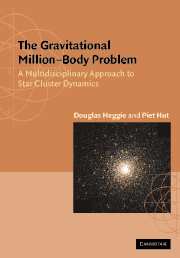Book contents
- Frontmatter
- Contents
- Preface
- PART I INTRODUCTIONS
- PART II THE CONTINUUM LIMIT: N → ∞
- PART III MEAN FIELD DYNAMICS: N = 106
- PART IV MICROPHYSICS: N = 2
- PART V GRAVOTHERMODYNAMICS: N = 106
- 16 Escape and Mass Segregation
- 17 Gravothermal Instability
- 18 Core Collapse Rate for Star Clusters
- PART VI GRAVITATIONAL SCATTERING: N = 3
- PART VII PRIMORDIAL BINARIES: N = 4
- PART VIII POST-COLLAPSE EVOLUTION: N = 106
- PART IX STAR CLUSTER ECOLOGY
- Appendix A A Simple N-Body Integrator
- Appendix B Hints to Solution of Problems
- References
- Index
18 - Core Collapse Rate for Star Clusters
Published online by Cambridge University Press: 05 June 2012
- Frontmatter
- Contents
- Preface
- PART I INTRODUCTIONS
- PART II THE CONTINUUM LIMIT: N → ∞
- PART III MEAN FIELD DYNAMICS: N = 106
- PART IV MICROPHYSICS: N = 2
- PART V GRAVOTHERMODYNAMICS: N = 106
- 16 Escape and Mass Segregation
- 17 Gravothermal Instability
- 18 Core Collapse Rate for Star Clusters
- PART VI GRAVITATIONAL SCATTERING: N = 3
- PART VII PRIMORDIAL BINARIES: N = 4
- PART VIII POST-COLLAPSE EVOLUTION: N = 106
- PART IX STAR CLUSTER ECOLOGY
- Appendix A A Simple N-Body Integrator
- Appendix B Hints to Solution of Problems
- References
- Index
Summary
The cruel fate of a system forever striving to be what it can never be – in thermal equilibrium.
J. GoodmanThe last two chapters have assembled most of the qualitative arguments by which the evolution of the core of a stellar system can be understood. In summary, the tendency towards equipartition drives the more massive stars to smaller radii. Unless their total mass is sufficiently small, equipartition cannot be reached by the time the heavier stars become essentially self-gravitating. When that happens they are eventually subject to the gravothermal instability. It is the purpose of the present chapter to flesh out this outline, but we shall do so in two passes, as it were. First we shall examine the time scales on which these processes act, and a number of factors which modify the simple picture; and we shall explain the qualitative nature of the resulting evolution. Then we turn to a more detailed description of one case which has been studied in great detail: self-similar collapse in systems with stars of equal mass.
The big picture
The time scale for equipartition, te, was discussed in Chapter 16 (see Eq. (16.14)). It is useful to compare it with the standard relaxation time tr (Eq. (14.12)). For this purpose we evaluate the mean kinetic energy per unit mass for each species by 〈Ei〉 = v2/2, independent of mass, i.e. we assume equipartition of velocities.
- Type
- Chapter
- Information
- The Gravitational Million–Body ProblemA Multidisciplinary Approach to Star Cluster Dynamics, pp. 172 - 178Publisher: Cambridge University PressPrint publication year: 2003



